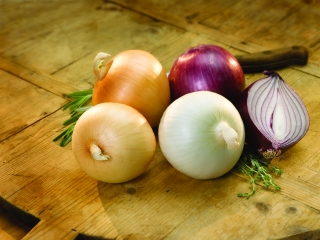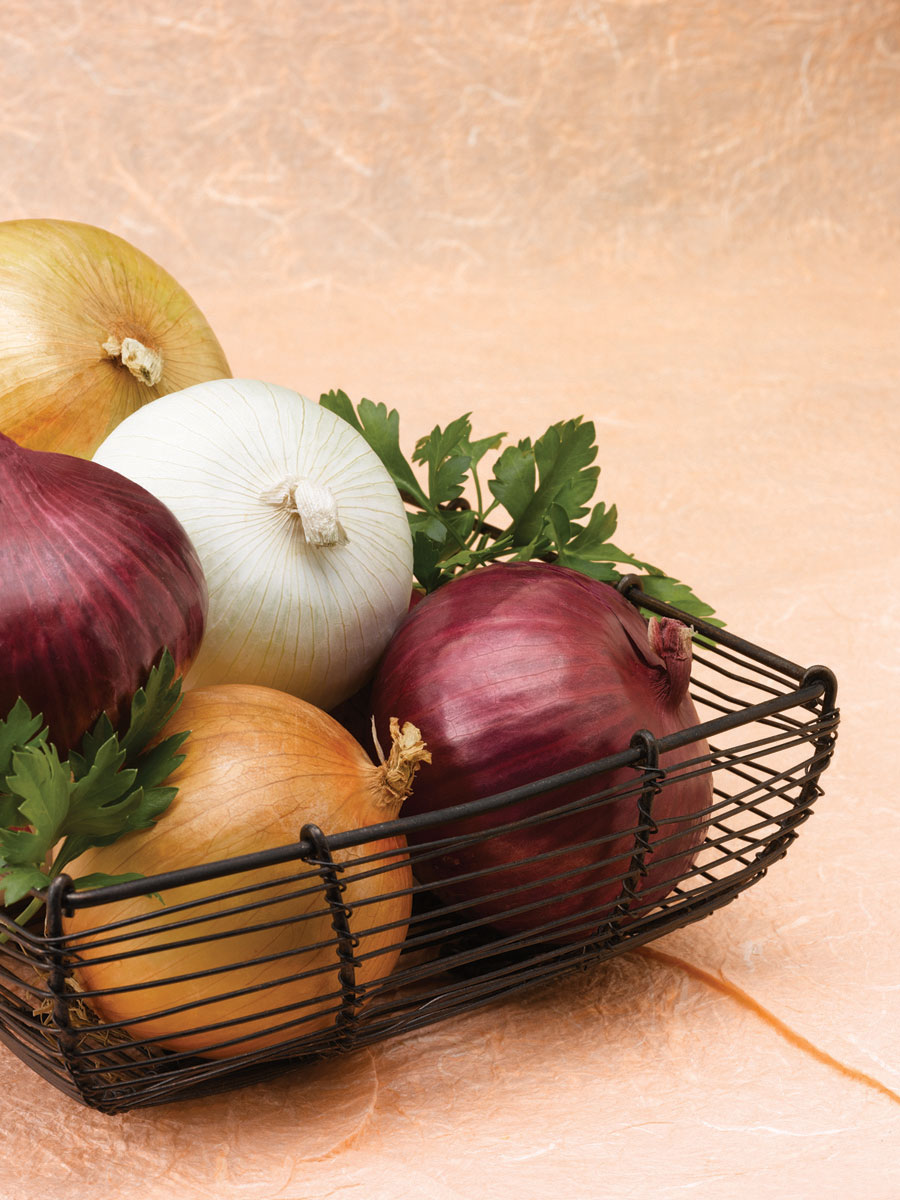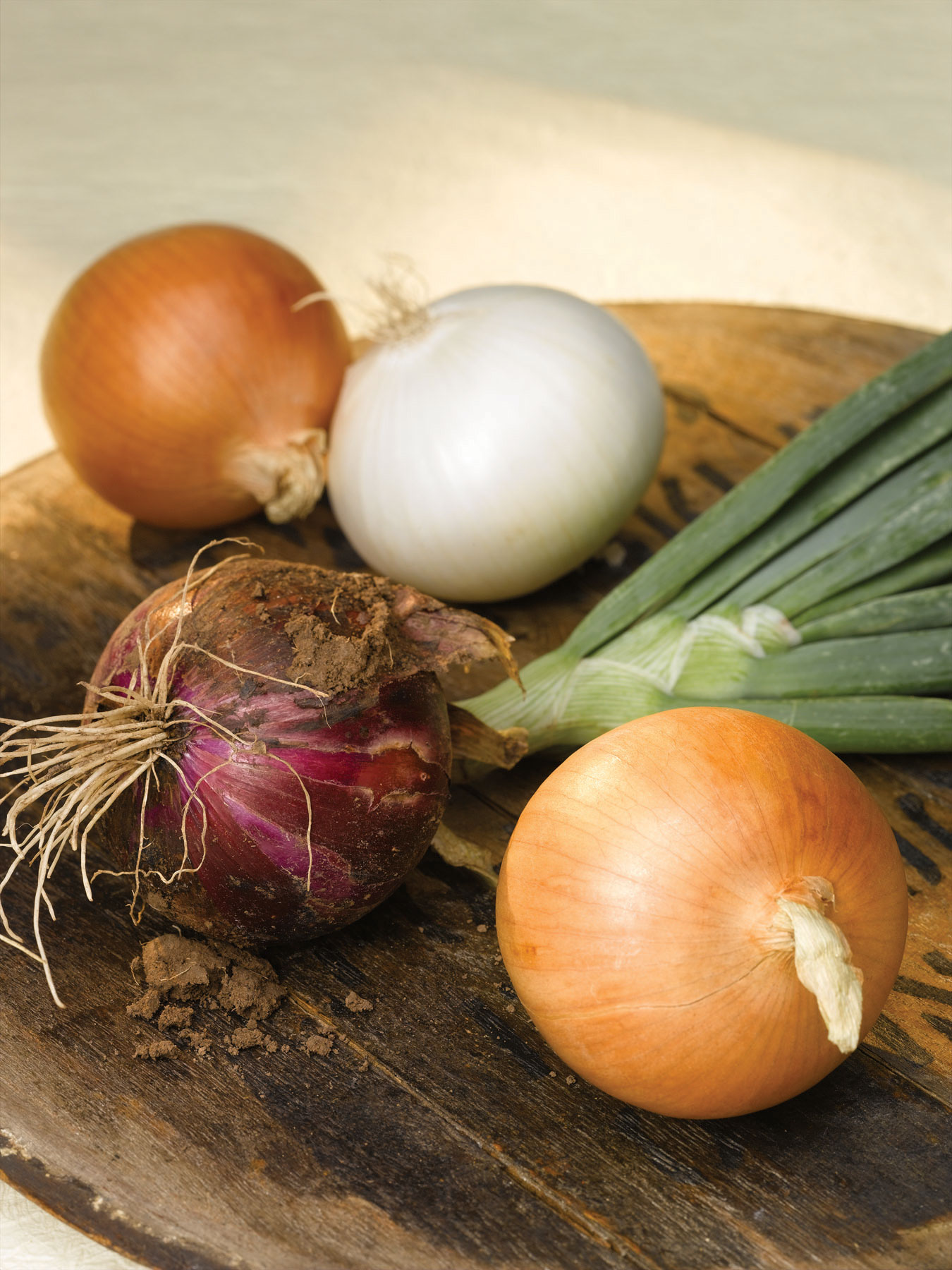
Onions’ Seasons, Colors and Flavors
01 March 2021Learn about the seasonality of onions including the differences between fresh and storage alliums. Try the classroom experiment to see and smell the differences.
By Rene Hardwick, National Onion Association

Onions are ubiquitous in the produce section and the most common vegetable mentioned on menus. Thus, many people do not realize onions are seasonal and the seasonality of onions greatly impacts the flavor. Based on when they are harvested, onions grown in the United States can be divided into two categories:
Spring/summer fresh onions are available in yellow, red and white throughout their season, March through August. Fresh onions can be identified by their thin, light-colored skins. Because they have a higher water content, they are typically sweeter and milder than storage onions. This higher water content also makes them more susceptible to bruising. With their delicate taste, fresh onions are the ideal choice for salads and other lightly-cooked or grilled dishes. Many specialty sweet onions are part of this category and are sold under specific trade names and labels.
Fall/winter storage onions are available August through April. Also available in yellow, red and white, storage onions are multiple layers of thick, dark, papery skins. Storage onions have an intense flavor and a higher percentage of solids. Storage onions are the best choice for savory dishes that require longer cooking times or more flavor, such as caramelized onions.
Bulb onions can be yellow, red, or white. Approximately 87 percent of the crop is devoted to yellow onion production, with about eight percent red onions, and five percent white onions. Yellow onions are full-flavored and are a reliable standby for cooking almost anything. Yellow onions turn a rich, dark brown when cooked and give French Onion Soup its tangy-sweet flavor. Red onions, with their wonderful color, are a good choice for lots of fresh uses or grilling, charbroiling, and roasting. White onions are often used in prepared salads, white sauces, and is the traditional onion for classic Mexican cuisine. They have a golden color and sweet flavor when sautéed.
Classroom taste test experiment
Spring is a great time to do a taste comparison of onions as both fresh onions and storage onions can be found across the country. Cut a yellow fresh onion (perhaps a brand of sweet onion) into large dices and place in individual containers. Do the same for storage versions of yellow onion. Provide students with a tasting sheet. Discuss how onions will vary depending on season. Which onion has a higher water content? Which onion will take longer to cook? Why? Consider cutting a yellow onion several hours in advance and then compare to freshly cut pieces. How does the flavor vary based on time? Add in dices of a fresh and storage red onion. How does the flavor compare?
As reference for this lesson, here is a glossary of allium terms:
Allium – the plant genus of onion which includes chive, garlic, leek, scallion and shallot. Alliums belong to the lily family; it is a diverse genus with edible and ornamental species.
Allium Cepa – cepa is Latin for onion and refers to the species of allium. There are hundreds of Allium species and even more cultivars or specific varieties. Allium cepa is the third largest fresh vegetable crop in the United States, the second most diversely consumed vegetable in the world, and the most widely traded raw vegetable on the globe.
Bermuda – a cultivar of onion in its original form that no longer exists in the United States. Many hybrid varieties have Bermuda genetics. Bermuda as a term is still used in USDA Grade Standards.
Cipollini – (pronounced chip-oh-lee-knee) small, flat onion with a sweet, yet developed allium flavor without being sharp. Cipollinis store well and can be used as a side dish, in stews or as a flavoring in sauces. Meant to be eaten whole, they are often pickled or marinated in balsamic vinegar.
Fresh Onion – synonymous for spring/summer onions harvested in the United States and available March through August. Fresh onions have one to two thin layers of skin, often transparent and lighter colored, especially the yellow varieties. They have a shorter shelf life and higher water content (lower dry matter) than varieties available at other times of the year.
Green Onion – plant with straight, hollow green leaves, a white shaft with no bulb. Produced from Allium fistulosum or cepa cultivars, both green and white parts are edible. They have a mild onion flavor and are usually eaten raw or used for garnish. (Often called scallions and bunching onions.)
Onion Powder – finely ground dehydrated onion.
Onion Salt – onion powder combined with salt.
Pearl Onion – onions measuring less than one-inch in diameter, they often have a mild flavor and are served as a side dish or pickled. (Also called Creamer Onion.)
Scallion –see Green Onion.
Sweet Spanish – large, globe-shaped onion with genetic origins in Spain. These varieties have fewer papery layers, store well, and tend to be mild, yet offer classic onion flavor.
Spring Onion or Mexican Green Onion - green onions with a small immature bulb typically used for grilling, but suited for long simmering. Like a green onion, both green and white parts are edible. (Also called a BBQ Onion.)
Storage Onion – synonymous for fall/winter onions harvested in the United States and available August through May. Storage onions have multiple layers of thick, paper-like skin that can be darker in color, especially the yellow varieties. They have a longer shelf life and lower water content (higher dry matter) than varieties available at other times of the year. (Also referred to as a cooking onion.)
Sweet – term used to describe the mildest varieties of onions. Many specialty onions are grown for this characteristic. A few U.S. trade names include Maui, Texas 1015s, Vidalia and Walla Walla.
Click here to find more information on onion colors and varieties at the National Onion Association website.
